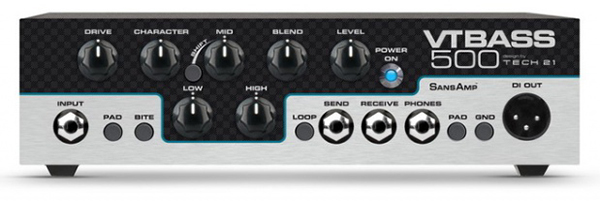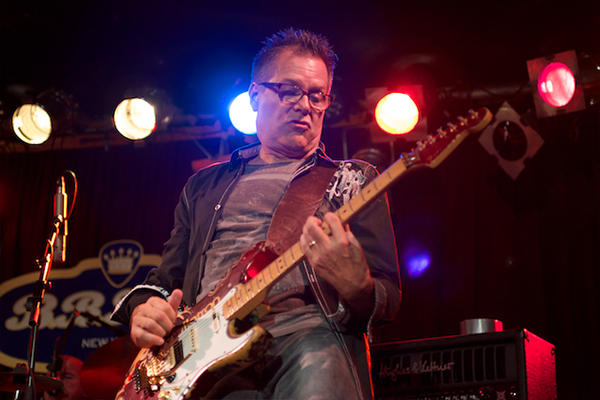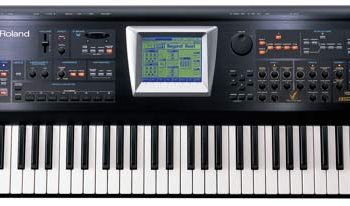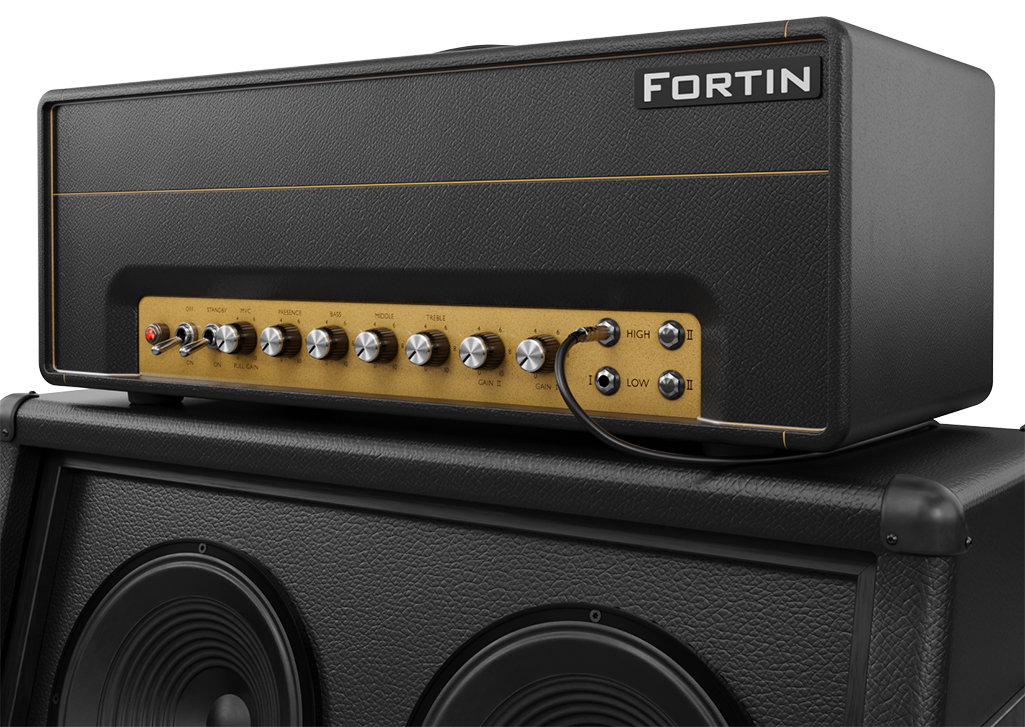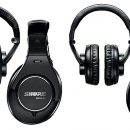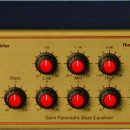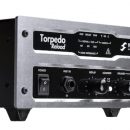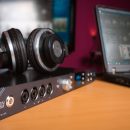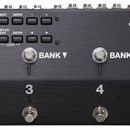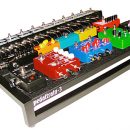 From the 1940s through the early 1960s, the bass amplifier was a fledgling tool initially built to amplify the upright bass to help it compete with the change in the music trends of the time. The Big Band era, with a powerful fifteen-piece brass section in a large dance hall, reduced sound of the lonely upright bass in a corner by the drums to a ghost of a thud in a crowd full of stomping swingers (dancing that is).
From the 1940s through the early 1960s, the bass amplifier was a fledgling tool initially built to amplify the upright bass to help it compete with the change in the music trends of the time. The Big Band era, with a powerful fifteen-piece brass section in a large dance hall, reduced sound of the lonely upright bass in a corner by the drums to a ghost of a thud in a crowd full of stomping swingers (dancing that is).
With the wattages of the first bass amplifiers in the low double digits, bass players were dependent on every decibel of volume they could squeeze out of these early workhorses. However, the combination of a pushed amplifier and the hollowbody construction of an upright bass was a recipe for feedback. The invention of the solidbody electric bass solved the feedback problem and started the low end revolution as we know it.
The limitations of those early bass amplifiers became evident as music changed yet again with the dawn of rock and roll. The volume of music began to increase even more, and bass players had to move even more air to be heard. Back then, typically, the only thing that was put through a PA system was the vocals, so when rock and roll started filling arenas, you depended on your amplifier on stage to deliver the goods to a vast audience. Higher wattage amplifiers became essential.
In the 1970s through the 1990s it became a given that if your bass amplifier didn’t weigh at least twice your body weight, you weren’t doing it right. Even weekend warriors in bar bands were gigging with Ampeg SVT amps and their monstrous, matching 8X10” cabinet.
When music evolved yet again and the bass guitar became more than just a low-end rhythm instrument, bass amplifiers became more hi-fi in order to broadcast the electric bass in its perfect sonic detail. Over this span of time, the bass amplifiers from each musical era, regardless of the wattage, defined the classic tones that we are all familiar with.
As technology advanced, amplifier designers were able to shed the extremely heavy components of the classic amplifiers and replace them with lightweight parts. This has made it possible for the entire bass community to enjoy bass tones of distinction at more than adequate volumes, with gear that does not require heavy machinery, superhuman body strength—or unlucky roadies, to transport.
This historic perspective leads us to Tech 21 and their new VT Bass 500 lightweight bass amplifier head. Since the inception of their bass related products, Tech 21’s concept has been to offer versatile professional bass gear that delivers both vintage and modern bass tones without the weight and maintenance of a tube amplifier. The VT Bass 500 marks the brand’s first mini, lightweight bass amplifier. Using their time-tested expertise in analog tube amplifier simulation and the latest in Class-D power amplifier design, this little lightweight amplifier is one serious tone machine!
Features
The Tech 21 VT Bass 500 is housed in a compact, steel chassis measuring 10.5” wide x 2.75” high and 8.5” deep, and weighs in at just 6.5lbs. All circuitry is 100% analog and solid state. The front panel has a series of familiar controls with a few unfamiliar ones. First and foremost, the VT Bass 500 is equipped with a single ¼” input jack with a selectable -10dB PAD button to optimize the input level for either active or passive basses. A bright but not obtrusive, blue LED indicates power. The easily accessible, vintage style knobs are labeled Drive, Character, Low, Mid, High, Blend, and Level. For an intuitive explanation, it is easiest to separate the controls of this amplifier into three sections.
Section 1 is the Tube Amplifier Emulation circuit. The controls that make up this section are Drive, Character, and the pushbutton labeled Bite. The Drive control is designed to simulate the effect of driving a tube output stage. The Character knob allows you to sweep through various parameters effecting tone and gain characteristics that deliver a palette of simulated classic tube amplifiers from a flip-top B15 style all the way to an SVT and beyond. The Bite pushbutton engages a presence boost.
Section 2 is the EQ section. The Low, Mid and High EQ knobs are all boost/cut +/- 18db, with the Low EQ centered at 55Hz. The Mid is accompanied by a Shift pushbutton which allows you to select the center frequency at 500Hz or 1kHz. High is centered at 3kHz.
Section 3 is the output section. This is comprised of the Blend and Level knobs. The Blend knob allows you to blend between the direct signal from your bass and the output of the Tube Amplifier Simulation circuitry (Section 1). The output of the blended signal goes through the EQ section (Section 2). The Level knob serves as a master output control.
The effects loop feature is located on the front panel with quarter-inch Send and Return jacks and a pushbutton labeled Loop that activates or bypasses the line-level circuit.
To take advantage of the tube simulation enhanced sound—which also emulates a miked speaker, there is also an XLR DI Out to feed into a live sound system or to your recording gear. The amp also has a -20dB pad for the DI Out.
With everything on the front panel, the rear panel is extremely simple. It has the power switch, AC input (standard IEC), voltage selector switch 120/110V - 220/240V, a vent for the internal, thermally-controlled fan, and two Speakon connector outputs. The power is rated at 500W at 4Ω and 300W at 8Ω with a minimum 4Ω load.
 |
There is an optional carrying case available specifically designed for this amplifier, as well as rack ears that adapt the amp for use in standard 19” racks. Plugging into the front-mounted headphone jack automatically bypasses the speaker output, but there is no standby switch for silencing the amp when switching instruments.
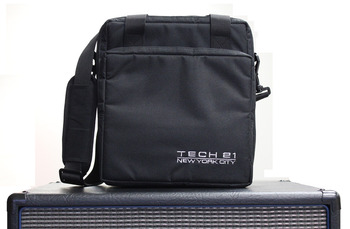 |
Usability
With most recent bass amplifier designs in general, you plug in your bass, turn the master volume up just enough for you to hear your bass signal, adjust the input level to the maximum input before clipping, tweak your EQ and turn the master volume up until you feel your pants flutter. If you venture past the half-way mark on the master volume, most of us would start cringing in fear of blowing a speaker or even worse, experiencing some unexpected stage pyrotechnics! (Guilty as charged!)
There are many great lightweight amplifiers on the market with the ability to enhance and amplify the natural tone of the bass. Some are known for a certain signature tonal voice and some are specifically designed for absolute transparency.
The VT Bass 500 is unlike most bass amplifiers because it is specifically designed to give you a full range of tube-simulated sounds, from clean to serious overdrive, with the adjustment of primarily two dials. There are more useable and distinctsounds available in the VT Bass 500 than from most amplifiers on the market today. We found a lot of dynamic interaction between all of the controls on the VT Bass 500, and in order to get the most of everything this amplifier has to offer, we had to change our way of thinking about bass amps just a bit.
The minimum mental hurdle to overcome was to understand that the Tube Amplifier Emulation circuit is part of the amplifier and not merely an effect. Just like when a guitar player dials in a little more hair or full overdrive on a classic Marshall, you have to balance the amount of input drive with the output volume. For once, you need to think like a guitar player. Oh, the humility!
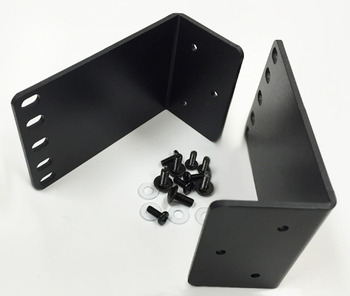 We found that the best way to begin exploring was to start with the Blend knob all the way clockwise, which fully engages the Tube Emulation Circuit and the EQ circuit. By balancing both the Drive and Character dials with the output Level dial, we were able to easily dial in some very rich tube-like tones for use in any application. Venturing past the 12:00 mark on the Drive and Character dials brings you into the realm of “slightly driven” to “full tilt distortion.” Although you can get some of the meanest and most olfactory satisfying distortion settings, depending on your preferences of course, it might not be practical for every gig. As we said before, this is a part of the amp circuit, so you can’t just stomp on a foot pedal to switch off the distortion. So, you are faced with the decision of dialing in a core amplifier sound for the gig, and if you require a switchable distortion, you would have to use a stomp-box or other outboard effect.
We found that the best way to begin exploring was to start with the Blend knob all the way clockwise, which fully engages the Tube Emulation Circuit and the EQ circuit. By balancing both the Drive and Character dials with the output Level dial, we were able to easily dial in some very rich tube-like tones for use in any application. Venturing past the 12:00 mark on the Drive and Character dials brings you into the realm of “slightly driven” to “full tilt distortion.” Although you can get some of the meanest and most olfactory satisfying distortion settings, depending on your preferences of course, it might not be practical for every gig. As we said before, this is a part of the amp circuit, so you can’t just stomp on a foot pedal to switch off the distortion. So, you are faced with the decision of dialing in a core amplifier sound for the gig, and if you require a switchable distortion, you would have to use a stomp-box or other outboard effect.
One very important thing to understand is the nature of the Blend knob. The Blend knob is designed to mix between the dry/direct bass input signal and the signal from the Tube Amplifier Emulation circuit. The Tube Amplifier Emulation circuit includes the Drive control, which can increase the gain of the signal. When the Blend is turned all the way counter-clockwise, that circuit is completely out so you are left with just the direct input signal and the EQ circuit.
In a studio workstation setting, having the connections on the front proved quite convenient. We used this compact head as a recording bass preamp and easily placed it on our desktop and ran the XLR direct output right into our DAW. In this scenario, we sometimes chose to turn the Blend control all the way counterclockwise and use just the dry signal. This gave us a pristine direct bass signal with the option to utilize the EQ stage. But of course, recording your bass with the tube emulation allows you to bring that tube essence to any recording project.
Sound
For our testing purposes, we used a few different cabinets including a 2x12” with a tweeter, a 2x10” with a tweeter, and a 15” speaker. We started with the Blend knob all the way clockwise, fully engaging the Tube Amplifier Emulation circuit, and the EQ flat. By keeping the Drive about 9:00 and sweeping the Character knob from fully counter clockwise to about 11:00, we began to explore the prescribed “Ampeg SVT” type sound. At the lower Character settings we were able to get a deep, round, throaty rumble with a low mid punch. With a passive P-Bass, we got the essence of classic rock, finger-style warmth, and for pick players, just enough attack to cut.
When we engaged the Bite button, the attack became much more prominent. As we swept the Drive up just before 12:00, the tube overtone qualities became more prominent, just like boosting a tube input stage. As we increased the Character knob toward the 12:00 position, we experienced a sweeping mid-range definition (not EQ) harkening back to some of the different models and modifications of the SVT. The boosted mid quality combined with a J-style bass spawned sounds reminiscent of early Rush with a low-mid, but slightly scooped, upper-midrange attack. With a bit of a style change, it was the perfect recipe for ‘70s thumb-poppin’ funk.
By adjusting the Drive level, we were able to dial in just enough growl for any style while maintaining that tubescent gliss. At about the 12:00 mark on the Character knob, the low end becomes less pronounced and the sound becomes more even and flat, which is the signature sound of the studio staple, B-15 flip-top. This has always been popular because you can benefit from its tube warmth, and with subtle adjustments of the EQ, you can get the bass sound just right to sit in any mix.
Although the EQ section works perfectly while exploring the SVT sounds, it becomes even more important and prominent with the B-15 style because of its “flat” nature. The Character at 12:00 and the Drive at 11:00 was our favorite setting for a “clean hi-fi” sound with a slight EQ boost of the Low and High knobs. Whether played with an active or passive bass, this setting delivered a great warm tone, but with mildly tube-compressed high end. For a great Hofner tone, we adjusted the EQ with a slight Low Mid boost. The low end just bloomed and the high end “thwonk” was perfectly enhanced with the tube overtones.
Now let us enter the VT Bass 500 museum of bass overdrive and distortion. With the Character knob fully counterclockwise and the DRIVE at about 3:00 a “fatbucker” bass like our modded MTD CRB with Gibson EB3 style pickups transformed into a Jack Bruce “Cream formula” groove machine. As we swept up the with the Character knob, the mids became more prominent, giving us a whole palette of useable overdrive sounds. The Bite button also changes the voice by adding presence to potentially muddy distortion settings. Even when we maxed the Drive and Character knobs, the buzz saw-like quality still presented us with a useable sound. In this case, it was beneficial to use the Blend knob to mix in some of the direct bass and boost the Low EQ to add some missing girth.
Since the distortion or overdrive does not function as an “effect” per se and is part of the gain structure of the amplifier, you do not have the option to switch it on and off. So one factor is that for gigging, you have to decide on a setting you are going to use for your main sound. One of the sounds we loved for a rich, full range bass sound with a touch of overdrive was the combination of an MTD bass with active Bartolini pickups, with both the Character and Drive knobs both just past 12:00. While maintaining the full piano-like tones of this bass, when we dug into the strings or strummed a bass chord, a subtle distortion forms over the top of the notes like a hot cappuccino.
Please note that with each of these settings, we had to adjust the output level accordingly since the tone is greatly dependent on the Drive and Character knobs, which can drastically change the gain characteristics.
One of the drawbacks of distortion effects pedals is the disappearance of the low end. In the case of the VT Bass 500, the low end seems to never disappear. Or, if it drops out a little bit, it is very easily corrected by adding some of the low end EQ. The Blend knob is typically used to balance the dry signal from the bass with the effected signal in order to preserve the bass low end while hearing the desired effect. We found that we didn’t need the Blend function for the most part since there was plenty of low end in the effected signal. Also, since the dry signal can be potentially lower than the effected signal because there is no gain stage, when we blended the dry signal with a distorted signal, the dry signal was minimal in comparison. Although the Blend function can be useful at lower gain settings and some extreme high gain settings, we got much more out of the 100% tube effected settings. Another thing that is most impressive is the minimal noise from this amp, even at the most overdriven settings!
A serious bonus with the VT Bass 500 is its ability to operate as a professional recording bass preamp, and the amp has a speaker modeling circuit built into the XLR output stage. A great way to utilizes the amp’s overdrive features for recording is to split your bass signal externally and record one direct track dry and another track with one of the overdrive settings from the VT Bass 500. Then, you can mix the two tracks to get just the right balance in the mix.
The VT Bass 500 excels at “personality,” and its compact size and weight are cause to rejoice. When you see those poor souls humping 300 lbs of bass amplifier to a club date, they are most likely doing it for the tone. It is the personality of that amplifier that gives them the sound they crave. The VT Bass 500 delivers the same thing… without hefty chiropractor bills.
Videos courtesy of Tech 21
Documentation and Product Support
As subtly complex as the VT Bass 500 can be, the documentation gives all of the specifics for the user to dial in a great tone. We definitely recommend reading it.
One of the coolest things about the manual is a pictorial list of suggested amplifier settings. This gives the user a great head start. It also gives you space to note your own settings as you discover them.
The product carries a one year limited warranty.
Price
The Tech 21 VT Bass 500 (MSRP $695) sells for approximately $499. At this price, it’s impossible not to love it.
Contact Information
Tech 21
www.tech21nyc.com
Overall Rating - Product Summary

